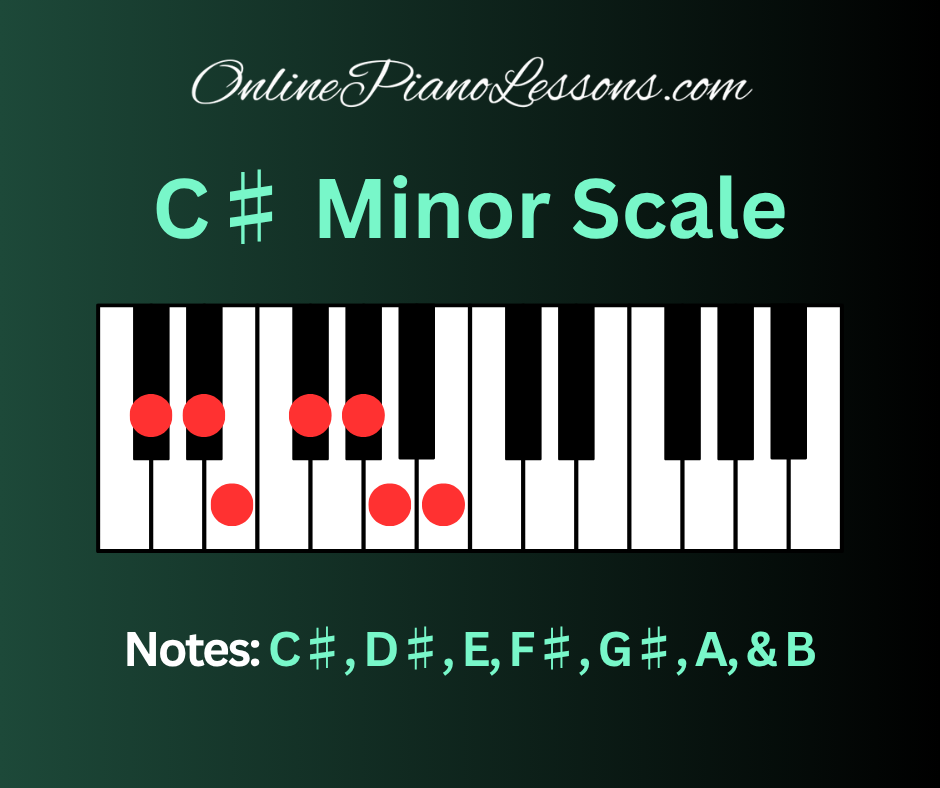
The C sharp minor scale is a rich, dramatic, and versatile key that appears often in piano repertoire and popular music. Whether you prefer the tiny, haunting elegance of a Chopin-esque nocturne or the thunderous climaxes of Romantic-era preludes, the C# minor scale on the piano delivers a distinctive tonal color that players and listeners find compelling. This guide explains what the C sharp minor scale is, how to find and play the C# minor scale on the piano, the different forms (natural, harmonic, melodic), common chords and progressions, fingerings, practice tips, and famous pieces written in C# minor.
Throughout this guide you’ll see the terms C sharp minor scale and C# minor scale used interchangeably; both refer to the same set of notes and the same key area on the piano.
What Is The C Sharp Minor Scale?
The C sharp minor scale (C# minor scale) is the minor scale whose tonic (home note) is C♯. It is the relative minor of E major, which means they share the same key signature of four sharps: F♯, C♯, G♯, and D♯. The basic natural C sharp minor scale contains the notes:
C♯ – D♯ – E – F♯ – G♯ – A – B – C♯
On the piano, these notes include both black and white keys: the C♯, D♯, F♯, and G♯ are black keys, while E, A, and B are white keys. Because of this mix of black and white keys, the C# minor scale can feel comfortable under the hand once you’re used to it—many pianists like how the black keys help guide finger placement.
Natural, Harmonic, And Melodic Forms
Like all minor keys, the C# minor scale has three commonly used forms in Western music notation and piano practice:
- Natural C# Minor Scale: C♯ – D♯ – E – F♯ – G♯ – A – B – C♯. This is the pure minor (Aeolian) form and is often used for modal or folk-like passages.
- Harmonic C# Minor Scale: C♯ – D♯ – E – F♯ – G♯ – A – B♯ – C♯. The harmonic form raises the seventh degree (B becomes B♯) to create a stronger leading tone to the tonic. On the piano B♯ sounds the same as C natural, so you will often play a C natural note in harmonic passages even though it is notated as B♯. The harmonic C# minor scale is essential for cadences and classical harmony because the raised 7th creates a convincing resolution back to C♯.
- Melodic C# Minor Scale:
-
-
Ascending: C♯ – D♯ – E – F♯ – G♯ – A♯ – B♯ – C♯ (raise 6th and 7th).
-
Descending: C♯ – B – A – G♯ – F♯ – E – D♯ – C♯ (typically reverts to natural minor on the way down).
On the piano, ascending melodic passages often use A♯ (the raised sixth) and B♯ (C natural) to smooth melodic motion. Descending, many composers revert to the natural minor to preserve the darker color.
-
When practicing the C# minor scale on piano, make sure to be aware of which form the music requires—scales, arpeggios, and cadences will often use different forms for musical effect.
Scale Degrees And Character
Each scale degree of the C# minor scale contributes to its emotional color:
- Tonic (C♯) — home, stability.
- Supertonic (D♯) — often used as a passing tone.
- Mediant (E) — defines the minor quality (minor third).
- Subdominant (F♯) — supports melodic work.
- Dominant (G♯) — important for tension and resolution.
- Submediant (A / A♯) — natural A gives a somber minor color; A♯ (melodic) brightens the line.
- Leading Tone (B / B♯) — B in natural minor is a subtonic and feels more open; B♯ (harmonic/melodic) is the true leading tone that pushes to C♯.
The C sharp minor scale on the piano often conveys melancholy, introspection, or seriousness, but it can also sound heroic when used in its harmonic or melodic variants.
Fingering For The C# Minor Scale (Practical Piano Tips)
Good fingerings make scale practice efficient and comfortable. The fingerings below are suggested starting points for the C# minor scale on the piano.
Right Hand (Ascending) — Natural/Melodic/Harmonic
1 (C♯) – 2 (D♯) – 3 (E) – 1 (F♯) – 2 (G♯) – 3 (A or A♯) – 4 (B or B♯) – 5 (C♯)
Right Hand (Descending)
5 – 4 – 3 – 2 – 1 – 3 – 2 – 1
Left Hand (Ascending)
5 (C♯) – 4 (D♯) – 3 (E) – 2 (F♯) – 1 (G♯) – 3 (A or A♯) – 2 (B or B♯) – 1 (C♯)
Left Hand (Descending)
1 – 2 – 3 – 1 – 2 – 3 – 4 – 5
These fingerings use thumb crossings at logical places (after third fingers) to accommodate the black-key positions. Experiment and adjust slightly for comfort—some pianists prefer different thumb placements depending on hand size and touch.
When practicing the C# minor scale on piano, use slow, even strokes, then gradually increase speed with a metronome. Practice hands separately first, then together. Include arpeggios and scale fragments to build agility.
Common Chords And Progressions In C# Minor
Understanding harmony helps you use the C# minor scale effectively on the piano. Common triads in C# minor (natural) are:
- i: C♯ minor (C♯–E–G♯)
- ii°: D♯ diminished (D♯–F♯–A)
- III: E major (E–G♯–B)
- iv: F♯ minor (F♯–A–C♯)
- v: G♯ minor (G♯–B–D♯) — often becomes G♯ major or G♯7 using harmonic minor
- VI: A major (A–C♯–E)
- VII: B major (B–D♯–F♯)
Common progressions using the C# minor scale on piano include:
- i – iv – V (C♯m – F♯m – G♯ or G♯7) — classical minor cadence when V is major/dominant.
- i – VI – III – VII (C♯m – A – E – B) — a common pop/rock minor progression.
- i – VII – VI – V (C♯m – B – A – G♯) — descending bass motion that’s very idiomatic on piano.
Use harmonic minor (with B♯) to create authentic classical-sounding dominant chords (G♯ major or G♯7) that strongly resolve to C♯ minor.
Arpeggios, Exercises, And Practice Routines
To internalize the C# minor scale on the piano, include these drills:
- Scale Octaves: Play the C# minor scale in octaves slowly, increasing speed gradually.
- Arpeggio Practice: Practice C♯m arpeggios (C♯–E–G♯) across several octaves in different inversions.
- Broken Chords: Play broken-chord accompaniments in the left hand while the right hand plays scale fragments.
- Chord Progression Loop: Improvise over i–VI–III–VII and experiment with melodic lines using the melodic minor for color.
- Sight-Reading In Key: Read simple pieces or exercises in C# minor to adapt hand shapes and muscle memory.
Consistent daily practice of short focused sessions (10–20 minutes) on scales, arpeggios, and progressions yields the best progress on the piano.
Famous Works In C# Minor
A few notable piano works in C# minor that demonstrate the key’s emotional power:
- Beethoven — Piano Sonata No. 14 in C♯ minor, Op. 27 No. 2 (“Moonlight”): The first movement is famous for its haunting C♯ minor atmosphere.
- Rachmaninoff — Prelude in C♯ minor, Op. 3 No. 2: A dramatic showpiece that highlights the key’s thunder and lyricism.
- Various film and pop pieces also use the C# minor scale to create moodiness and tension.
Learning phrases from these works can deepen your familiarity with the C# minor scale on piano and inspire interpretive choices.
Musical Character And Uses
The C sharp minor scale often conveys somberness, introspection, or haunting beauty on the piano. The availability of both white and black key textures makes its voicings rich and comfortable under the hands. Composers choose the C# minor scale when they want an emotional color that is dark but has enough brightness (thanks to black-key accidents) to move to heroic or luminous moments when raising the sixth or seventh degrees.
FAQ
What notes are in the C sharp minor scale?
The natural C# minor scale contains C♯, D♯, E, F♯, G♯, A, B, C♯. The harmonic and melodic variants raise the seventh (to B♯) or raise the sixth and seventh (A♯ and B♯) ascending.
Is C sharp minor the same as D flat minor?
No — D♭ minor is the enharmonic equivalent of C♯ minor but is impractical (many flats). C♯ minor is the standard notation for this key on piano.
How many sharps does the C# minor key signature have?
Four sharps: F♯, C♯, G♯, and D♯ — the same as its relative major, E major.
What famous pieces are in C# minor?
Beethoven’s “Moonlight” Sonata (first movement) and Rachmaninoff’s Prelude in C♯ minor are two well-known examples that make the key famous on the piano.
Should beginners practice the C# minor scale on piano?
Yes. Despite containing several black keys, the C# minor scale is very practical for beginners and helps develop comfortable hand shapes and accurate fingerings.





 Hi, I'm Thomas, Pianist Composer,
Hi, I'm Thomas, Pianist Composer,  I love playing piano, creating new melodies and songs, and further developing my online piano course and making updates/additions to my site OnlinePianoLessons.com!
I love playing piano, creating new melodies and songs, and further developing my online piano course and making updates/additions to my site OnlinePianoLessons.com!  Now that is what I call fun!
Now that is what I call fun!





